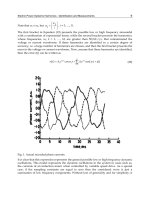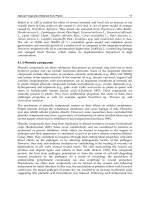Chapter 103. Polycythemia Vera and Other Myeloproliferative Diseases (Part 2) doc
Bạn đang xem bản rút gọn của tài liệu. Xem và tải ngay bản đầy đủ của tài liệu tại đây (11.9 KB, 5 trang )
Chapter 103. Polycythemia Vera and Other
Myeloproliferative Diseases
(Part 2)
Etiology
The etiology of PV is unknown. Although nonrandom chromosome
abnormalities such as 20q, trisomy 8, and especially 9p, have been documented in
up to 30% of untreated PV patients, unlike CML no consistent cytogenetic
abnormality has been associated with the disorder. However, a mutation in the
autoinhibitory, pseudokinase domain of the tyrosine kinase JAK2—which replaces
valine with phenylalanine (V617F), causing constitutive activation of the kinase—
appears to have a central role in the pathogenesis of PV.
JAK2 is a member of an evolutionarily well-conserved, nonreceptor
tyrosine kinase family and serves as the cognate tyrosine kinase for the
erythropoietin and thrombopoietin receptors. It also functions as an obligate
chaperone for these receptors in the Golgi apparatus and is responsible for their
cell-surface expression. The conformational change induced in the erythropoietin
and thrombopoietin receptors following binding to erythropoietin or
thrombopoietin leads to JAK2 autophosphorylation, receptor phosphorylation, and
phosphorylation of proteins involved in cell proliferation, differentiation, and
resistance to apoptosis. Transgenic animals lacking JAK2 die as embryos from
severe anemia. Constitutive activation of JAK2 can explain the erythropoietin-
independent erythroid colony formation, and the hypersensitivity of PV erythroid
progenitor cells to erythropoietin and other hematopoietic growth factors, their
resistance to apoptosis in vitro in the absence of erythropoietin, their rapid
terminal differentiation, and their increase in Bcl-X
L
expression, all of which are
characteristic in PV.
Importantly, the JAK2 gene is located on the short arm of chromosome 9,
and loss of heterozygosity on chromosome 9p, due to uniparental disomy is the
most common cytogenetic abnormality in PV. The segment of 9p involved
contains the JAK2 locus; loss of heterozygosity in this region leads to
homozygosity for the mutant JAK2 V617F. Over 90% of PV patients express this
mutation, as do approximately 45% of IMF and ET patients. Homozygosity for the
mutation occurs in approximately 30% of PV patients and 60% of IMF patients;
homozygosity is rare in ET. Over time, a portion of PV JAK2 V617F
heterozygotes become homozygotes, but usually not after 10 years of the disease.
PV patients who do not express JAK2 V617F are not clinically different than
those who do, nor do JAK2 V617F heterozygotes differ clinically from
homozygotes. In general, patients who express JAK2 V617F are older than those
who do not, but they do not have a longer duration of disease.
JAK2 V617F is the basis for many of the phenotypic and biochemical
characteristics of PV, such as elevation of the leukocyte alkaline phosphatase
(LAP) score and increased expression of the mRNA of PVR-1, a
glycosylphosphatidylinositol (GPI)-linked membrane protein; however, it cannot
solely account for the entire PV phenotype. First, PV patients with the same
phenotype and documented clonal disease lack this mutation. Second, IMF
patients have the same mutation but a different clinical phenotype. Third, familial
PV can occur without the mutation, even when other members of the same family
express it. Fourth, not all the cells of the malignant clone express JAK2 V617F.
Fifth, JAK2 V617F has been observed in patients with long-standing idiopathic
erythrocytosis. However, while JAK2 V617F alone may not be sufficient to cause
PV, it is essential for the transformation of ET to PV, though not for its
transformation to IMF.
Clinical Features
Although splenomegaly may be the initial presenting sign in PV, most often
the disorder is first recognized by the incidental discovery of a high hemoglobin or
hematocrit. With the exception of aquagenic pruritus, no symptoms distinguish PV
from other causes of erythrocytosis.
Uncontrolled erythrocytosis causes hyperviscosity, leading to neurologic
symptoms such as vertigo, tinnitus, headache, visual disturbances, and transient
ischemic attacks (TIAs). Systolic hypertension is also a feature of the red cell mass
elevation. In some patients, venous or arterial thrombosis may be the presenting
manifestation of PV. Any vessel can be affected, but cerebral, cardiac, or
mesenteric vessels are most commonly involved. Intraabdominal venous
thrombosis is particularly common in young women and may be catastrophic if a
sudden and complete obstruction of the hepatic vein occurs. Indeed, PV should be
suspected in any patient who develops hepatic vein thrombosis. Digital ischemia,
easy bruising, epistaxis, acid-peptic disease, or gastrointestinal hemorrhage may
occur due to vascular stasis or thrombocytosis. Erythema, burning, and pain in the
extremities, a symptom complex known as erythromelalgia, is another
complication of the thrombocytosis of PV. Given the large turnover of
hematopoietic cells, hyperuricemia with secondary gout, uric acid stones, and
symptoms due to hypermetabolism can also complicate the disorder.
The plasma erythropoietin level is a useful diagnostic test in patients with
isolated erythrocytosis, because an elevated level excludes PV as the cause for the
erythrocytosis.









